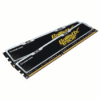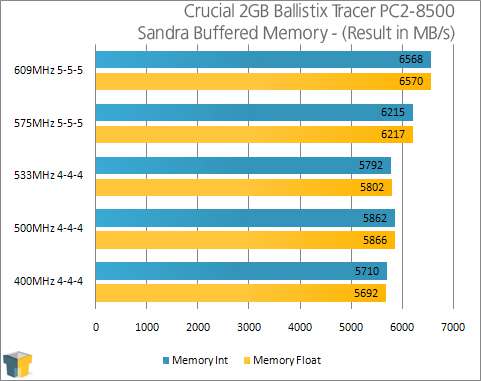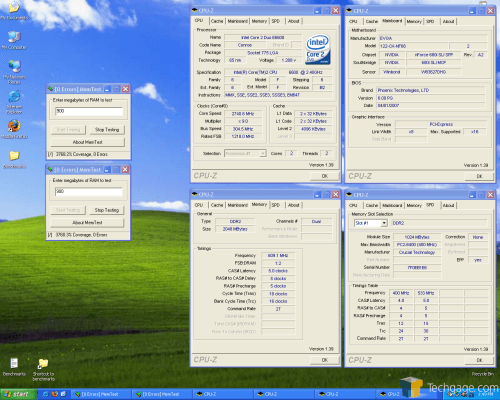- Qualcomm Launches Snapdragon 4 Gen 2 Mobile Platform
- AMD Launches Ryzen PRO 7000 Series Mobile & Desktop Platform
- Intel Launches Sleek Single-Slot Arc Pro A60 Workstation Graphics Card
- NVIDIA Announces Latest Ada Lovelace Additions: GeForce RTX 4060 Ti & RTX 4060
- Maxon Redshift With AMD Radeon GPU Rendering Support Now Available
Crucial 2GB DDR2-1066 Ballistix Tracer

It’s not often that Crucial releases a new high-end kit, but they’ve finally caught up to everyone else and released Ballistix clocked at DDR2-1066. Today we are taking a look at the Tracer version and look to see how far we can push them over stock.
Page 2 – Overclocking and Testing Methodology, Sandra
Ahh, how interesting overclocking would be with these modules. I mentioned that I didn’t have much luck at all with their PC2-6400 kit, so I was a little skeptical jumping into this one. Before overclocking, I always look for the retail price in order to wager who the modules are targeted towards. If it’s a $400 kit, it should be far more overclockable than a $200 kit, for example.
One popular e-tailer sells the modules for ~$270, but includes a mail-in rebate that will drop it straight down to $209. Oddly enough though, there are other e-tailers (that you might see in our affiliate ads) that are selling the kit for $199 without any sort of rebate. At that price range, this is a great kit even for stock speeds. Those LEDs really do add to the value if you love to pimp your PC.
Thanks to the good price, I didn’t expect superb overclocking, but I was wrong. Here are my stable overclocked settings:
- 400MHz (DDR2-800), 1.9v, 4-4-4-12-13
- 450MHz (DDR2-900), 2.1v, 4-4-3-12-13
- 500MHz (DDR2-1000), 2.1v, 4-4-4-12-13
- 533MHz (DDR2-1066), 2.3v, 4-4-4-12-13
- 575MHz (DDR2-1150), 2.4v, 5-5-5-18-13
- 609MHz (DDR2-1218), 2.5v, 5-5-5-18-16
My goal was 600MHz, but these modules proved 100% stable at 609MHz. When I state 100%, I mean it passes at least 1000% in MemTest for Windows and also a full 3D Mark 06 run.
609MHz is not a record breaking overclock, but given the price, it’s superb. $200 DDR2-1066 modules that overclock to DDR2-1200 stable… it’s a good thing.
I am very pleased with the overclocking potential in these modules. If you have the potential to go beyond 2.5v, you might be able to push them a bit further. I hit a serious wall, however. 612MHz crashed Windows as soon as it logged on, 611MHz allowed me to open a benchmark. 610MHz crashed the PC when I opened up Photoshop. 609MHz proved 100% stable all around, throughout everything. What a difference a megahertz makes.
Throughout all of our benchmarks regardless of what we are reviewing, testing is done in a clean and stand-alone version of Windows XP Professional with SP2. Prior to testing, these conditions are met:
- Desktop and scrap files are cleaned up, including emptying of recycle bin.
- No virus scanner or firewall is installed in the stand-alone installation.
- The stand-alone installation drive is completely defragged using Diskeeper 2007 Professional.
- All unnecessary programs are closed, so that Windows should have no more than 15 active processes running.
- Computer has proper airflow.
The testing rig used for today’s benchmarking is as follows:
- CPU: Intel Q6600 (2.4GHz – 2.89GHz)
- Motherboard: eVGA nForce 680i (P27 BIOS)
- Memory: Crucial 2GB PC2-8500 Tracer
- Video: ASUS EN8800GTX 768MB
- Sound: Onboard HD Audio
- Storage: Seagate 7200.9 320GB
- Etcetera: Windows XP Professional w/ SP2
- Cooling: Corsair Nautilus 500
(Products linked are to our own reviews)
Sandra is always the first benchmark to come to mind when we need to do memory benchmarking. Or CPU benchmarking. Or storage benchmarking. You get the idea. It’s a superb all-around tool that we rely on quite often.

Good results all around, but it’s too bad we couldn’t a wee bit closer to the 7K mark. Let’s move onto Everest, Sciencemark and Super Pi.
Support our efforts! With ad revenue at an all-time low for written websites, we're relying more than ever on reader support to help us continue putting so much effort into this type of content. You can support us by becoming a Patron, or by using our Amazon shopping affiliate links listed through our articles. Thanks for your support!






